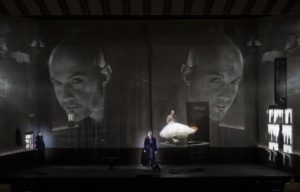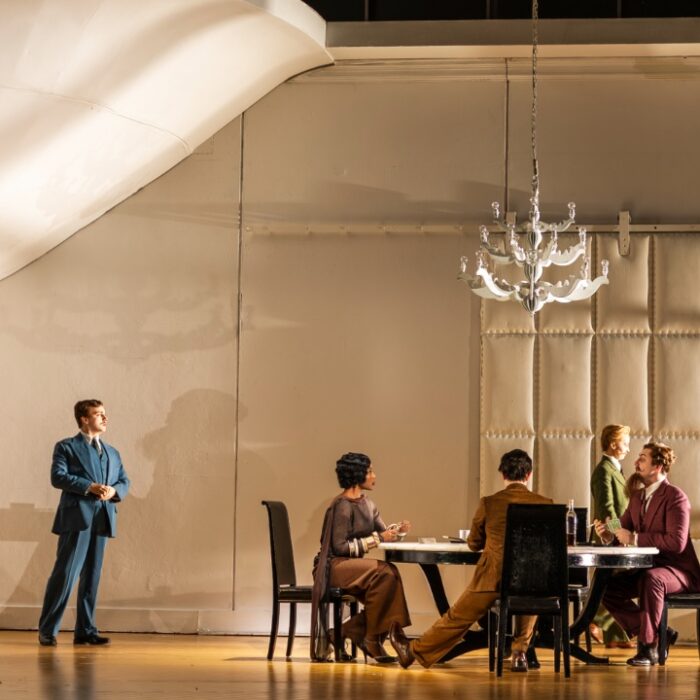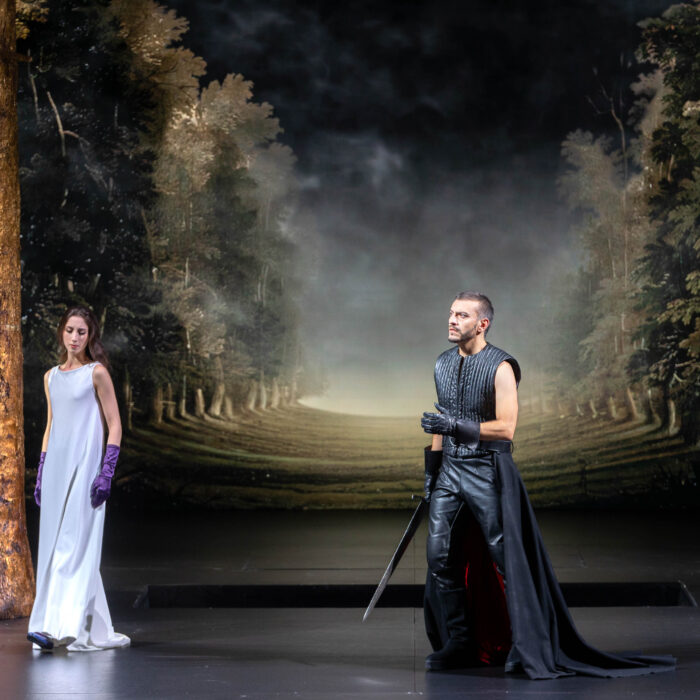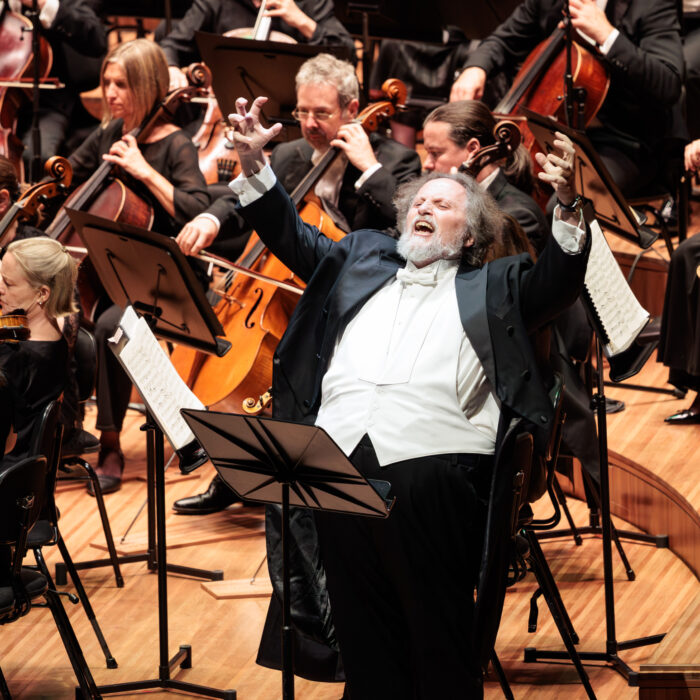
Palau de les Arts 2021-22 Review: Les Contes d’Hoffmann
John Osborn & Pretty Yende Shine in this Fantastic Critical Edition of the Famed French Comedy
By Mauricio VillaAfter struggling with the general rise in COVID infections, the Palau de Les Arts managed to lift its curtain to present “Les Contes d’Hoffmann” on the 23rd of January, after cancelling the original premiere date of January 20th. Expectations were high, as this production used one of the most complete critical editions (by M. Kaye & J.C. Keck), which contains a lot of extra music that has been rarely performed before.
It also marked the role debut of Pretty Yende, taking on the three female protagonist roles.
Marc Minkowski, famous for his musicological research, conducted the production, which included extra arias for Nicklausse and Dapertutto, new duets for Hoffmann and, with the exception of the famous “barcarolle,” a whole new Giulietta act. Eighty percent of the music that appears in this edition has rarely, if ever, been performed in the history of Offenbach’s only opera.
The opera concludes with an “apotheosis” ensemble scene, making the ending triumphant, as opposed to the traditional, sad last “la muse” aria. Offenbach died before finishing the score, leading to a situation where, ever since its premiere, the piece has been reorganized and reinterpreted by those who intend to perform it. This has created multiple versions of the score, although Choudens’ first published edition has become the one traditionally used.
Uncut
The M. Kaye & J.C. Keck edition features three hours of music, performed without the traditional cuts of second verses in arias and duets. Minkowski presented Offenbach’s work with astounding energy, choosing exaggerated, fast tempi and reinforcing the timbrical colors of the orchestra, especially the wind section. He outlined the brightness of the score above the dark, dramatic momentum present in several pieces. The Orchestra de la Comunitat Valenciana sounded strong and clear, and the harp solo received spontaneous applause following the interlude between Giulietta’s Act and the Epilogue. The Cor de la Generalitat Valenciana were balanced and bright in the several interventions they had in Offenbach’s masterpiece: a real accomplishment, considering that they sang in masks throughout due to COVID restrictions.
American bel-canto tenor John Osborn portrayed the titular Hoffmann. He demonstrated his seamless vocal technique and stamina which helped him finish the performance with a fresh-sounding voice. This was a very long version of the opera, and neither Osborn’s arias nor duets had any cuts.
He possesses a lirico-leggero voice with a middle register that has gained volume and consistency, making him ideal for a difficult role which demands complete control across the tenor’s entire vocal range. Osborn’s entrance, “Bon jour ami,” was strong, aggressive and determined, portraying in this first line Hoffmann’s rage and frustration. He colored his voice, darkening the sound without losing projection, to navigate the baritonal tessitura of the Epilogue.
He presented an ardent and forceful “Balad du Kleinzack,” maintaining emotion and navigating the passagio section of the voice with ease. He also delivered delivered a ringing high C to finish the piece. Yet he could also become melancholic, particularly when he colored his voice with sweetness as he mentioned “troi maîtresse.”
Osborn managed to produce a younger sound for Olympia’s Act, as Hoffmann is supposed to be in his early twenties, and sang the long lyrical phrases with and amazing crescendo/diminuendo, delivering secure, ringing B flats. He sang the aria “Ah vivre deux” with passion and melancholy, using an exquisite mezza voce.
Osborn sang Antonia’s Act with delicacy, navigating easily through the long melodic lines which rise up to a high B natural. Osborn’s range is so wide, and his high notes are emitted so effortlessly, that B naturals and high Cs sound like the natural progression of Offenbach’s melodies, rather than the climatic big, high notes that more lyrical or spinto tenors sing. The necessity of casting heavy tenor voices for Hoffmann is a misconception, however. The orchestration when Hoffmann is singing is not strong, so a big voice is not needed to be heard. Secondly, as happens in Antonia’s Act, the score demands “sweet singing” in a high tessitura. Osborn’s vocalitá is the closest to the real French romantic tenor, due to his flexibility, astounding use of dynamics and effortless high notes.
Osborn can sound heroic and menacing as well, however. This he did excellently in his first Giulietta aria “Amis, l’amour tendre et reveur,” which he sang with its original two verses. He perfectly hit several B flats, even interpolating a high C at the end. His second aria, “Oh dieu! D quelle ivresse,” also displayed his ability to sing comfortably in a high tessitura written above the passaggio, moving constantly between high G and A in long legato lines. Osborn sang the last verse with pianissimo, delivering an exquisite, soaring high A.
After a long night of singing, this edition includes a repetition of “Kleinzach” in a higher key, demanding the tenor reach a high D natural and two C sharps. Osborn showed his impressive high register by being able to sing this devilishly high line seamlessly after three hours of performing. Osborn presented a melancholic, romantic, personification of the tormented poet, being expressive, moving, and believable all at the same time.
Three Heroines
South African soprano Pretty Yende had the tremendous task of singing all three heroines, whose vocal writing differs from one to the other so dramatically that they are usually performed by three different sopranos. Yende’s voice is turning into a pure lyrical instrument as her middle register grows and darkens. The bel canto repertoire that she has been singing until now, however, has enabled her to sing all the coloratura and high notes of Olympia during the first act. She interpolated several extra E flats on her famous “doll song” aria, “Les oiseaux dans le charmille.” She maintained control to sing staccato high notes, but the ending E flat proved to be a bit heavy for the singer, who only just maintained the note. Yende had problems on the coloratura section at the end of the act, breathing during fast scales, which broke her momentum and had the effect of putting her slightly behind the music and muddying the coloratura. That said, she delivered an immaculate trill on the high D at the end of her intervention.
Antonia proved to be the most suitable role for Yende’s voice. The lyrical writing, keeping the voice in the middle register but with ascensions up to a D natural, suited Yende’s instrument perfectly. Her voice sounded powerful, dark, brilliant and expressive. Her trio with the bass and the mezzo was thrilling and emotional and became the highlight of her performance.
Giulietta’s role is written for a lyric soprano in this version—the role has been traditionally performed by mezzo-sopranos due to the low writing in the earlier editions of the score—giving an optional version of Giulietta’s aria “L’amour lui dit” for a leggera soprano. The score is filled with fast scales, staccato notes and several high B flats. Yende chose the lyrical version of the aria, which maintains a central writing and goes no higher than an A natural, showing the development of Yende’s voice into pure lyrical.
Filling In the Cast of Characters
Italian bass-baritone Alex Esposito portrayed the four ‘evil’ characters. He gave a truthful, detailed personification of every character, avoiding the typical cliches and providing his interpretation with dramatic depth. The doctor Miracle became the real personification of the devil, and was Exposito’s strongest interpretation. Ultimately, Esposito used all his vocal resources to create four completely different villains, singing with an impeccable French style and strong projection. It was a pity that this version did not include the famous, beautiful bass aria “Scintille diamant,” and instead used the unknown but less lyrical “Tourne, tourne, miroir.”
Irish mezzo-soprano Paula Murrihy sang the double role of La muse/Nicklausse. She possesses a rich voice with a fair vibrato, modest volume, but secure in the high register. This she elegantly displayed in the several ringing B naturals that she sang during the performance. The mezzo’s role is significantly expanded in this critical edition thanks to the addition of numerous new pieces. These include two arias as well as large interventions within ensemble numbers. Murrihy sang this demanding part easily and portrayed a young energetic companion of the aloof Hoffmann.
Dutch tenor Marcel Beekman was brilliant in his personification of the four short comic tenor roles. He has incredible projection, which made his voice audible over the rest of the cast. His facility to color and define every line seemed endless, creating an amazing contrast between all four roles. His interpretation of Franz’s aria “Jour et nuit” was amusing, and he showed the richness of his voice in a brilliant pianissimo A natural and a strong sustained ending high G.
Lacking Clarity
German stage director Johannes Erath presented a strong theatrical production. Beginning with a downstage curtain in the Prologue which displayed a mirror image of the interior of Les Arts Theatre, there were constant references throughout the performance to the theatre’s interior architecture.
The set was three rooms, one inside the other, creating a wonderful illusion of perspective, while the idea of “reflection,” first evoked in the Prologue, was maintained throughout by two mirrors which duplicated the image of the rooms ad infinitum. Erath used multiple theatrical resources—lighting, projections, trap doors, deconstructing the set, mirrors and dancers—to make every scene and act of the opera unique. Using the same set for all the acts and the leitmotif of a long, white ball dress—which the characters hold and caress and which the soprano wears in every act—gave a wonderful sense of continuum.
The production was entertaining and effective, but the concept which the director wanted to present was unfortunately not clear at all. The plot of the opera was consequently confusing, and the actions seen on stage were a far cry from Jules Barbier’s original libretto. To be quite frank, it got to a point where one did not understand what was happening onstage at all.
Ultimately, the Palau de Les Arts’s decision to present the most exhaustive critical edition of Offenbach’s unique opera ever, proved truly formidable. However, the production, while entertaining, was confusing and cast a dark shadow on the rest of the production.


